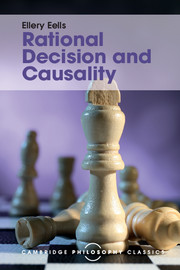Book contents
- Frontmatter
- Dedication
- Contents
- Preface to this edition
- Preface
- Introduction
- 1 Bayesianism
- 2 The philosophical and psychological significance of Bayesian
- 3 Bayesian decision theories: some details
- 4 The counterexamples
- 5 Causal decision theories
- 6 Common causes, reasons and symptomatic acts
- 7 A general defense of PMCEU
- 8 Newcomb's paradox
- Appendix 1 Logic
- Appendix 2 Probability
- Bibliography
- Index
2 - The philosophical and psychological significance of Bayesian
Published online by Cambridge University Press: 05 July 2016
- Frontmatter
- Dedication
- Contents
- Preface to this edition
- Preface
- Introduction
- 1 Bayesianism
- 2 The philosophical and psychological significance of Bayesian
- 3 Bayesian decision theories: some details
- 4 The counterexamples
- 5 Causal decision theories
- 6 Common causes, reasons and symptomatic acts
- 7 A general defense of PMCEU
- 8 Newcomb's paradox
- Appendix 1 Logic
- Appendix 2 Probability
- Bibliography
- Index
Summary
Decision theory and other theories, maxims and principles about human behavior often have both normative and descriptive interpretations. Such is the case with SEU theory. As normative, it is a theory about how we should make decisions; as descriptive, it is a theory about how we do make decisions. Both as a normative and as a descriptive theory, it is a model of human rationality. As normative, the theory is an outline of part of a philosophical account of the concept of rationality: it is a theory about how one's actions, preferences, values and beliefs must be related to each other for them to be rationally so related. Thus, it is not surprising that the theory has been applied to philosophical problems in areas where the concept of rationality is central: epistemology and moral theory. In this chapter, I will explore some ways in which SEU theory can be applied in the theories of induction and value. As descriptive, SEU theory is an outline of a psychological account of human behavior. Thus, it is not surprising that the theory has been put to much empirical test. In this chapter, I will also describe some of this empirical research and discuss its descriptive and normative implications for SEU theory.
Finally, there is an aspect of SEU theory which, perhaps, is properly a part of the descriptive aspect but which, because of its special and detachable philosophical importance, I will distinguish as ‘the explanatory aspect’. According to this part of the theory, preference and choice phenomena are explainable in terms of theoretical degrees of belief and degrees of desire: one makes certain choices and has certain preferences because of the existence of certain theoretical entities: certain degrees of belief and desire. Thus, preference and choice are the observable manifestations of degrees of belief and desire. This suggests the possibility that these degrees can be measured from their observational manifestations. And, indeed, the representation theorems, described earlier, show that this can, in principle, be done. Of course it must be argued that the theoretical entities lying behind choice and preference are actually degrees of belief and degrees of desire. And a dispositional theory of belief and desire – what might be called the philosophical foundations of this explanatory aspect of SEU theory and this measurement technique – makes this plausible.
- Type
- Chapter
- Information
- Rational Decision and Causality , pp. 22 - 58Publisher: Cambridge University PressPrint publication year: 2016



